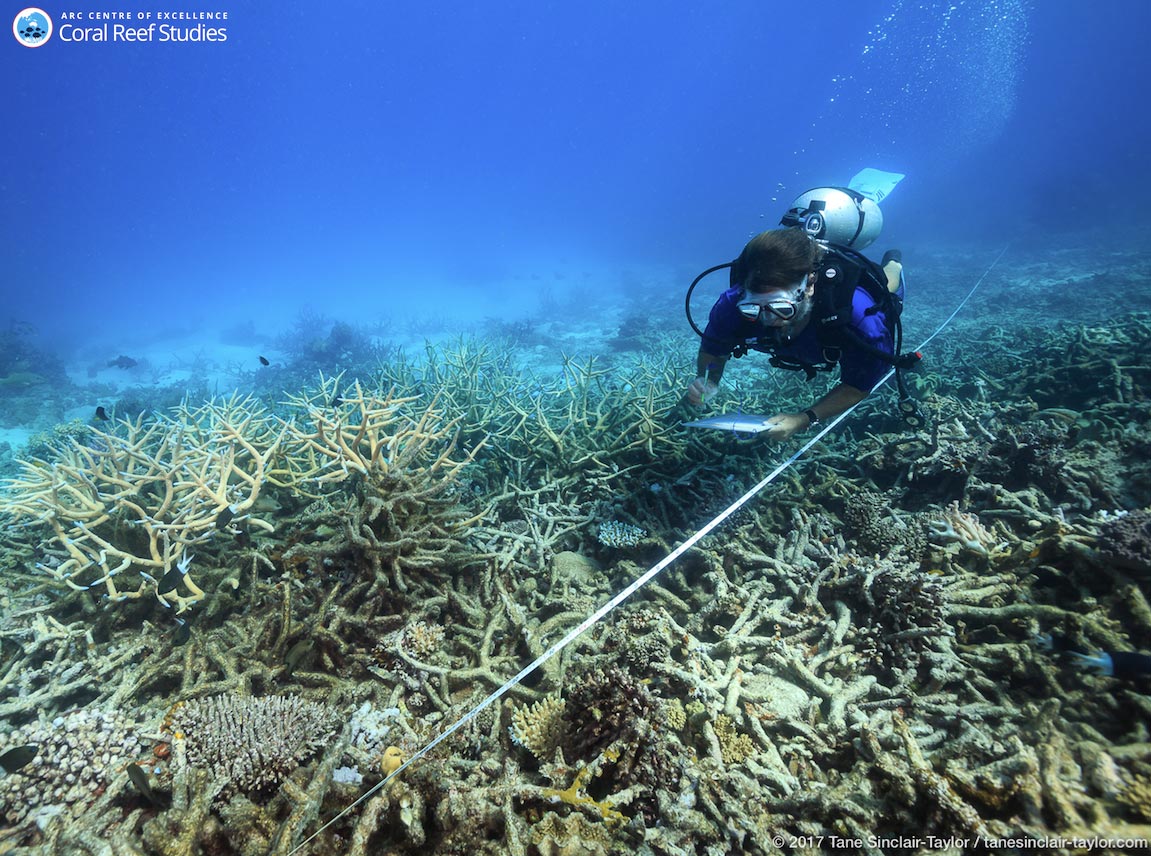Scientists mobilise as bleaching resumes on Great Barrier Reef
Coral researchers are remobilising to conduct aerial and underwater surveys along the Great Barrier Reef and elsewhere in Australia as coral bleaching reappears for the second year in a row. The decision coincides with the release today of a study in the prestigious journal Nature, which warns that the Reef’s resilience is rapidly waning.

Scientists and Reef managers from ten research institutions across Australia, representing the National Coral Bleaching Taskforce, have returned to the Reef only one year after scorching temperatures in 2016 caused the worst coral bleaching event on record. Teams will spend the next few weeks in the air and underwater measuring the extent of the damage from this summer compared to last.
“We’re hoping that the next 2-3 weeks will cool off quickly, and this year’s bleaching won’t be anything like last year. The severity of the 2016 bleaching was off the chart,” explains lead author and Taskforce convener, Prof. Terry Hughes (ARC Centre of Excellence for Coral Reef Studies). “It was the third major bleaching to affect the Great Barrier Reef, following earlier heatwaves in 1998 and 2002. Now we’re gearing up to study a potential number four.”
“We have now assessed whether past exposure to bleaching in 1998 and 2002 made reefs any more tolerant in 2016. Sadly, we found no evidence that past bleaching makes the corals any tougher.”
While protecting reefs from fishing and improving water quality is likely to help bleached reefs recover in the longer term, the study also revealed that it made no difference to the amount of bleaching during the extreme heatwave of 2016.
Co-author Dr Janice Lough, Senior Principal Research Scientist at the Australian Institute of Marine Science, says average sea surface temperatures for the Australian summer of 2016 were the highest ever recorded on the Great Barrier Reef. “In each of the three events since 1998, the pattern of bleaching matches exactly where the warmest water was each year. That allows us to predict when and where bleaching is likely to occur this year.”
“Global warming is the number one threat to the Reef. The bleaching in 2016 strongly reinforces the urgent need to limit climate change as agreed by world leaders in the Paris Agreement, and fully implement the Reef 2050 Plan to boost the Reef’s resilience,” says co-author Dr David Wachenfeld from the Great Barrier Reef Marine Park Authority.
“It broke my heart to see so many corals dying on northern reefs on the Great Barrier Reef in 2016,” says Prof. Hughes, who led the expansive aerial surveys. “With rising temperatures due to global warming, it’s only a matter of time before we see more of these events. A fourth event after only one year is a major blow to the Reef.”
The paper “Global warming and recurrent mass bleaching of corals”, by 46 co-authors, appears today in the journal Nature.
Notes to editors
The research institutions associated with the National Coral Bleaching Taskforce are: ARC Centre of Excellence for Coral Reef Studies, James Cook University, Australian Institute of Marine Science, CSIRO, Great Barrier Reef Marine Park Authority, NOAA, University of Queensland, University of Sydney, University of Western Australia, and WA Department of Parks and Wildlife.
Key points from the study:
- 2015-2016 saw record temperatures that triggered a massive episode of coral bleaching across the tropics
- Coral bleaching events should no longer be thought of as individual disturbances to reefs, but as recurring events that threaten the viability of coral reefs globally
- The Great Barrier Reef has had three major bleaching episodes, in 1998, 2002 and 2016, with the latest being the most severe and with catastrophic levels of bleaching occurring in the northern third of the Reef (a region approximately 800 km or 500 miles in length)
- The amount of bleaching on individual reefs in 2016 was tightly linked to local heat exposure
- The cumulative, superimposed footprint of the three mass bleaching events on the Great Barrier Reef has now encompassed virtually all of the Great Barrier Reef
- Past exposure to bleaching in 1998 and 2002 did not lessen the severity of the bleaching in 2016
Coral bleaching occurs when abnormal environmental conditions, like heightened sea temperatures, cause corals to expel tiny photosynthetic algae, called ‘zooxanthellae’. The loss of these colourful algae causes the corals to turn white, and ‘bleach’. Bleached corals can recover if the temperature drops and zooxanthellae are able to recolonise them, otherwise the coral may die.
Current reports of coral bleaching can be submitted to the Great Barrier Reef Marine Park Authority’s “Eye on the Reef” program: eyeonthereef@gbrmpa.gov.au
IMAGES http://bit.ly/2ncB0Wb
(Images must carry credits as listed in Dropbox folder)
More Information
Media Enquiries:
Professor Terry Hughes
Director, ARC Centre of Excellence for Coral Reef Studies, James Cook University
Phone: +61 (0)7 4781 4000 (AEST)
Email: Terry.Hughes@jcu.edu.au
Professor Andrew Baird
Phone: 0400 289 770
Email: andrew.baird@jcu.edu.au
Dr. Mia Hoogenboom
Phone: +61 (0)7 4781 5937 (AEST)
Email: mia.hoogenboom1@jcu.edu.au
Prof Morgan Pratchett,
Phone: +61 (0)488 112 295 (AEST)
Email: morgan.pratchett@jcu.edu.au
Kylie Simmonds
Communications Manager ARC Centre for Coral Reef Studies, James Cook University
Phone: +61 0428 785 895
Published:
16, March 2017